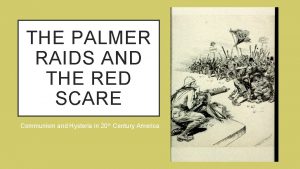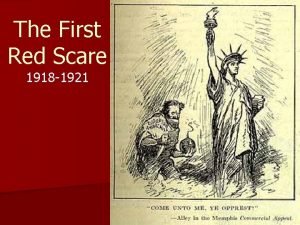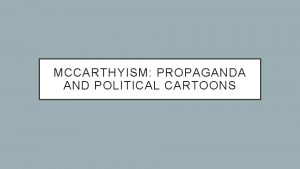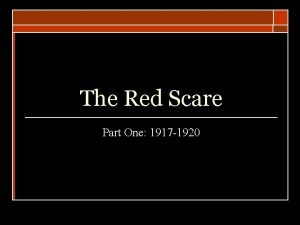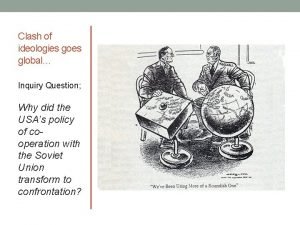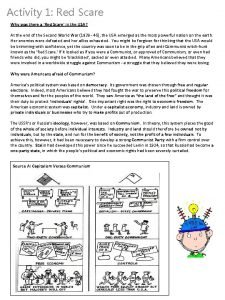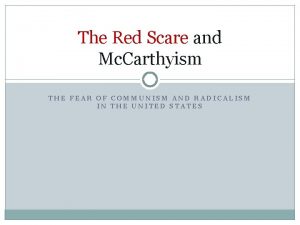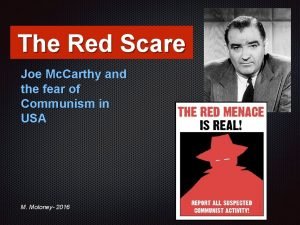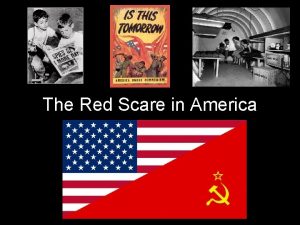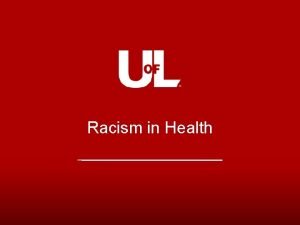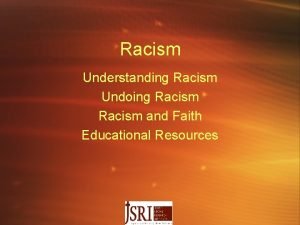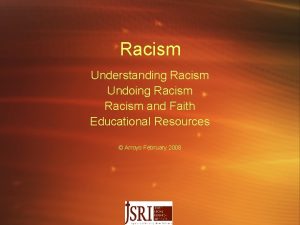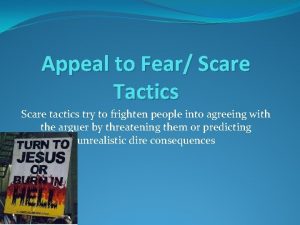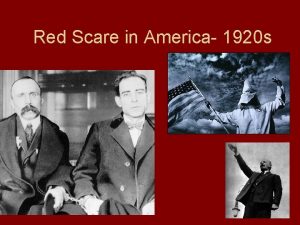Racism The Red Scare 1910 s1930 s Racism













- Slides: 13

Racism & The Red Scare 1910 s-1930 s

Racism & The Red Scare: My Q’s How did the Great Migration affect social relations in Northern cities? Describe the Chicago Race Riot in at least three sentences. Why did the membership of the KKK grow after WWI? How did the National Orgins Act of 1924 reflect growing nativism in America? How did the Palmer Raids reflect the ideas of the Red Scare?

The Great Migration In 1900 the vast majority of the 10 million African- Americans in the U. S. lived in the rural South as impoverished sharecroppers. Among many things, Jim Crow laws, problems with severe poverty, and racial violence convinced many southern blacks to move north. Others moved north for the wealth of job opportunities available in the north. The movement of hundreds of thousands of blacks from 1890 -1920 is known as The Great Migration.

Racism in the North The Great Migration only caused racism to worsen in the North. Immigrants, who often competed with blacks for jobs, sometimes were the most prejudiced. During economic downturns when white and blacks competed for jobs and housing, racial violence occurred often.

Racial Intolerance in the North Segregation was not imposed by law in the North, but racial intolerance influenced sale practices in the housing market. Blacks were often only allowed to buy houses in the worst areas of the city and because of where they lived attended the worst schools. Moreover, black males and females were limited to the kind of jobs they could get because of racism.

Race Riots & Violence Racial intolerance, especially after WWI, was known to result in racial violence that sometimes exploded into riots. Anti-black rioters in Atlanta in 1906 murdered 25 blacks and burned down dozens of homes. From 1900 -1920, an average of about 75 lynchings occurred each year. Many of the black men killed were still in their WWI uniforms—men who were willing to die overseas were killed at home because of bigotry.

The Chicago Race Riot of 1919 The biggest race riot occurred in Chicago where southern blacks had recently moved in and started to compete for jobs. On a hot afternoon, whites at a Lake Michigan beach threw stones at a black kid trying to swim, causing him to drown. Understandably, the black neighborhoods erupted in anger. For 13 days, blacks and whites randomly attacked each other and burnt each others houses down. The Chicago Race Riot left 15 whites and 23 black dead, hundreds injured, and thousands of black families homeless.

African American man stoned to death during the Chicago Race Riot. .

Immigration & Nativism Before World War I, immigrants from southern and eastern Europe continued to flock to America in search for a better life. However, nativism—a belief that native-born Americans are superior to foreign born immigrants—surged after WWI. The KKK’s membership boomed at this time because of their anti-immigrant, racist stances. The KKK was known to harass, injure, and even murder Catholic and Jewish immigrants. Many actually wanted to control the supposedly inferior immigrant population through eugenics, a system of controlling how a certain population reproduces. Eugenics is controlling how a certain population reproduces.

Anti-Immigration Quotas Since many wanted to limit foreign immigration, quotas, or allowing only a certain number of people in the country, were enforced. The National Origins Act of 1924 only allowed 2% of a certain national origin into the country based on the existing immigrant population already in the U. S. This quota law and system lasted until 1965 and because of this law, reduced total immigration from 1. 2 million in 1914 to just 280, 000 by 1929. Another provision in the law excluded all Asians from obtaining citizenship.

American Communism During WWI, the Russians abandoned the allies because it was undergoing a communist revolution under the new Bolshevik regime in Russia. Therefore, after the war, many Americans were worried that communism would take root in their country. When strikes against businesses occurred after the war, they were often seen as communist actions. A small minority were actually communists and even a smaller minority of these communists were known to commit acts of violence and espionage.

The Red Scare After several communist bombings of congressmen’s houses, anti-communist hysteria—called the Red Scare—took political form. Several communist congressmen, though elected, were banned from taking their positions. The Justice Department also created a task force devoted to locating, arresting, and deporting communists. In December 1919 alone, the government deported 249 Russian-born, illegal immigrants because of the Red Scare.

The Red Scare Continued On January 2, 1920, a set of coordinated raids, called the Palmer Raids, targeted suspected communist houses and headquarters in 32 cities. Without search warrants or arrest warrants, the FBI arrested 4, 000 suspects and illegally seized papers and records. In one raid, the police targeted a group of men and women looking to co-own a bakery. The Red Scare died down in a few years after the American people realized that a communist revolution in America would never happen.
